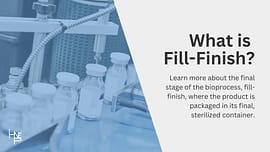Single-Use Pumps in Biopharma
Learn how single-use pumps are utilized in bioprocesses, and how HPNE has a variety of solutions to your single-use pump needs.
What is a Single-Use Pump?
Stainless steel pump solutions were traditionally used in the biotech and biopharma industries. This posed challenges such as increasing time between use for cleaning and maintenance. To overcome this challenge, the industry evolved to use single-use pumps, which had disposable components - most often pump heads - that allowed users to shorten change-out times, and maintain more constant levels of sterility.
The Application of Single-Use Pumps in Biopharma
This shift mentioned above to single-use pumps has been heavily influenced by the costs associated with cleaning, maintenance, quality control, and operations of multi-use pumps when preparing between processes. Quaternary Diaphragm pumps are one of the main pumps used in biopharmaceutical production. These pumps use an eccentric shaft to move four quaternary diaphragms, actuating check valves. Luckily, the configuration of quaternary diaphragm pumps are easily adaptable to a single-use format, as seen with the line of pumps from Quattroflow.
Benefits of Moving Away from Stainless Steel
There are a variety of benefits that are generated when switching to single-use pumps, which are detailed below.
Decreased Expenses
Not only are stainless steel pumps expensive to obtain, but you can expect an increase in labor costs, as it will cost your team extra time to clean the pump in between each use. Additionally, to ensure different pharmaceutical products meet industry standards, pumps must be validated for aspects like sterility. These additional validations between use are costly and time-consuming. When utilizing a single-use pump, the disposable components usually come pre-validated, and can easily be replaced with clean components when you are finished using them.
Reduced Risk of Product Contamination
As mentioned above, in between cleanings, it is likely that your stainless steel pump will need to be validated to ensure it meets cleaning validation requirements. This proves that it is not guaranteed the cleaning and sanitization process between uses will remove all potentially harmful particles. When using single-use pumps, all components that come into contact with the product will be removed entirely, ensuring no particles are left behind on the pump. Being that each single-use component can be sterilized, you can be ensured that each new single-use component is safe and ready to use.
Increase Product Speed to Market
With the aforementioned reduction in cleaning and validation times, you can also increase the rate at which your products get to market. Many patients and customers rely on products developed, at least in part, with biopharmaceutical pumps. With the reduced downtime stemming from single-use pumping solutions, you can get your products to the patients who need them quicker.
Flexibility of Use
In our previous article regarding single-use assemblies, we discuss the flexibility granted to users from single-use solutions in relation to their stainless steel counterparts. This is because stainless steel equipment is made to be used in a specific process for an extended period of time. However, in the quickly evolving biopharma and biotech markets, it is important that our equipment be able to grow with us. As single-use components on single-use pumps are changed between uses, there is more flexibility in altering what the single-use portion of the pump is designed for. This ultimately increases the likelihood that your pump can be used in a wider variety of processes, and can remain applicable even when your processes change.
Enhance Your Single-Use Pump Process with HPNE
High Purity New England (HPNE) has a variety of single-use pumps, and their team of experts can work with you to determine the best pump for your needs. Their single-use pump offerings feature their FlowMaxx Pro, which can integrate both flow and pressure sensors. Additionally, they offer a line of single-use quaternary diaphragm pumps from Quattroflow, and single-use pumps like the Precision Pump and Q-Drive-Alpha from Quantex, a PSG brand. Furthering their offering, they also offer their single-use TFF system OptiMaxx as well as their HPConnexx™ Single-Use Assemblies and Single-Use Components which can be integrated into a custom, sterilized flow path to work with any of their single-use pumps.
Environmental Implications of Single-Use Pumps
Due to the reduction in treatments like CIP/SIP, single-use pumping solutions can reduce up to 85% of overall water usage. There can also be a large reduction in energy usage when bypassing CIP/SIP validation because there is no need to produce clean steam. The flexibility of a single-use pump can also reduce waste, as you do not need to obtain an entirely new pump each time you would like to start a new process.
To learn more about single-use technology in the biopharma and biotech industries, visit our article “What is Single-Use Manufacturing?”.
Share article
About HPNE
As the industry needs grow, High Purity New England, Inc. continues to supply the biopharmaceutical industry with a range of innovative products, from drug discovery and development to fill-finish, including their flagship product, custom single-use assemblies, as well as pumps, sensors, bioreactor systems, storage and handling solutions and other single-use solutions. Along with their own manufactured products for the global market, they are also a distributor for more than 18 brands in North America.




